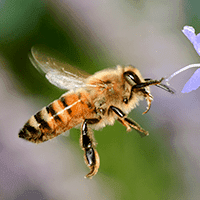
Honey Bees

Honey bees are a social species of stinging insects that are very beneficial to the environment. Honey bees play a major role in the pollination of crops, plants, and flowers all across the world. A single honey bee colony may survive and remain active for several years.
Honey Bee Identification
Honey bees are most often light golden brown in color and have a darker brown banding; their coloration may vary depending on the specific species, however, honey bees will always have lighter and darker color variations that create a banding pattern on their bodies. Their bodies are covered in a layer of fine hair, adult workers grow to between 1/2 and 5/8th of an inch in length; workers are the members of the colony that are most often seen by people. Queens are larger and can grow up to 3/4 of an inch in length. Honey bees have a barbed stinger coming off of their thorax (hind-end); the barbed stinger means that each bee can only sting a victim once.
Habits & Life Cycle Of Honey Bees
Every individual honey bee colony has one queen; she is responsible for producing all the members of the colony. Workers are responsible for gathering the food sources for the queen and the developing larvae. Each honey bee colony can have thousands of members in it; when the colony becomes mature the newly produced queens will fly from the colony, mate with drones (fertile males), and return to the colony to gather a group of workers. This new group of a single queen and sterile workers will go off to a new area to build a new nest and new colony. Honey bees tend to create their nests in tree cavities, in bushes, in the spaces between rocks, inside of attics, wall voids, underneath of decks, or in other spots that are up off of the ground. Honey bees are fairly docile and generally only sting when their colony is being threatened. A sting from a honey bee is quite painful and the venom is strong enough to cause serious health consequences for some individuals.
Honey Bees Damage
Honey bees aren’t generally responsible for causing major structural damage to your home, however, having a honey bee hive full of bees and honey is not ideal to have behind the walls of your home. A hive located inside your home can potentially lead to some moisture problems and attract other pests to your home. Also, a hive located in or very near an exit or entrance of your home can increase the likelihood of you, a family member, or pet being stung.
Honey Bee Control
Honey bees are a protected species, are very environmentally beneficial, and if at all possible should be left alone. However, if a honey bee colony has been created in or near your home and they have become a danger to you or your family members, the professionals at American Pest Solutions recommend calling a local beekeeper to come evaluate the situation and potentially remove the colony.
Honey Bee Prevention
Being able to completely stop honey bees from choosing your property to nest on is impossible; but, there are some steps you can take around your property to make it less appealing to them. Honey bee prevention tips include:
- Placing woodpiles a distance away from the outside of your home; honey bees often create their hives in woodpiles.
- Placing fruit and vegetable gardens a distance away from the exterior of your home.
- Removing fallen trees and piles of organic debris from your property.
- Making sure that chimneys have tight-fitting caps on them; repair holes found along the roofline.
- Sealing cracks and gaps found in your home’s foundation and exterior walls.

Trust Massachusetts' oldest family owned pest control company to protect your family & home.